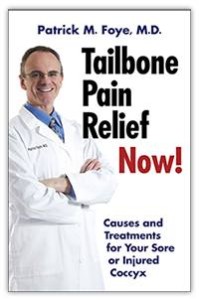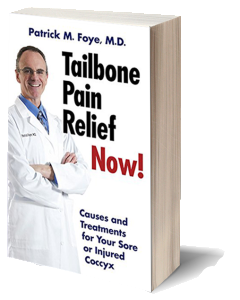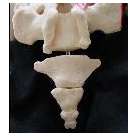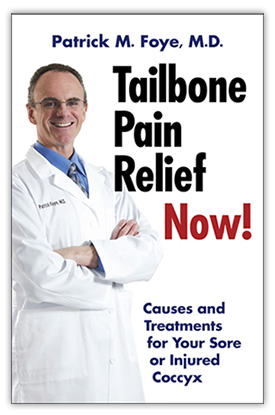- The best and worst of sitting surfaces varies from person to person with tailbone pain.
- Many people find a hard surface to be better because then they can sit on the other to sit bones (the ischial bones, or ischial tuberosities, which is the bony spot at the bottom of each buttock cheek), and avoid or minimize having the seat make contact with the coccyx.
- If the seat is too soft, then the ischial bones just sink into the cushion which lowers the coccyx to a point where it makes contact with the seat/cushion.
- Other people with tailbone pain prefer a softer surface.
- If the chair or cushion is too hard, then pressure from the chair or cushion may cause excessive pressure on other nearby body regions, such as the ischial bones (the “sit bones” at the bottom of each buttock cheek), or on the piriformis muscle is the lower part of each buttock.
- Sometimes the sciatic nerve in the area of the piriformis muscle can also be affected, causing nerve pain that shoots down the leg.
To come to Dr. Foye’s Tailbone Pain Center:
Tailbone Pain Book:
To get your copy of Dr. Foye’s book, “Tailbone Pain Relief Now!” click on this link: www.TailbonePainBook.com
 Book: “Tailbone Pain Relief Now! Causes and Treatments for Your Sore or Injured Coccyx” by Patrick Foye, M.D.
A tailbone fracture (“a broken coccyx”) takes longer to heal than fractures at most other body regions.
There are multiple reasons for this:
- Unlike fractures at many other body regions, there is no cast, splint, or brace that can be put on a fractured tailbone.
- Alike fractures at many other body regions, there is no way to avoid putting your body weight on the fracture (unless you totally avoid sitting for several weeks).
- So, a tailbone fracture never really gets a chance to rest and recover the way that fractures at most other body regions do.
- So, it is not surprising that much longer than fractures that most other body regions.
- It’s also not surprising that tailbone fractures are more likely to go on to develop chronic, ongoing pain.
To come to Dr. Foye’s Tailbone Pain Center:
Tailbone Pain Book:
To get your copy of Dr. Foye’s book, “Tailbone Pain Relief Now!” click on this link: www.TailbonePainBook.com
 Book: “Tailbone Pain Relief Now! Causes and Treatments for Your Sore or Injured Coccyx” by Patrick Foye, M.D.
Some patients ask whether medical marijuana can be used to decreased tailbone pain (Coccyx pain, coccydynia).
Is marijuana legal in your state? Can you use it for tailbone pain?
- Whether or not marijuana is considered legal depends on the state and/or country that you live in.
- Overall, compared with the last 60 years or so, the tide has turned. There are an increasing (dare I say “growing”) number of states are allowing for more liberal use of medical marijuana and even recreational marijuana.
- It depends on the state you live in.
- Some states classify marijuana as illegal regardless of whether it is for medical use or for recreational use.
- Some states considered medical marijuana to be legal, but recreational marijuana to be illegal.
- Some states consider marijuana to be legal regardless of whether it is for medical use or for recreational use.
- Of those that only allow marijuana for medical use, some states are more strict than others on which particular medical conditions the marijuana can be prescribed for.
- Here in New Jersey, medical marijuana is very restricted. In New Jersey, medical marijuana can only be prescribed to certain specific conditions (ALS, multiple sclerosis, etc.). Coccyx pain (tailbone pain) is NOT among those conditions for which marijuana can be legally prescribed in New Jersey. In New Jersey, the law also limits it so that prescription of medical marijuana can only be done by specially-designated physicians (the vast majority of physicians in NJ can not prescribe it).
- Interestingly, at the federal level my role on a currently remains illegal. Most likely that will eventually change, since it is problematic to send mixed messages where the federal government says something is illegal in the entire country but the individual states that make up the country say that it is legal within their own state.
To come to Dr. Foye’s Tailbone Pain Center:
Tailbone Pain Book:
To get your copy of Dr. Foye’s book, “Tailbone Pain Relief Now!” click on this link: www.TailbonePainBook.com
 Book: “Tailbone Pain Relief Now! Causes and Treatments for Your Sore or Injured Coccyx” by Patrick Foye, M.D.
For people with Tailbone Pain, the x-rays/MRI/CT-scans often FAIL to even include the Tailbone, even though that is the source of the person’s pain
- Many patients experience frustration with finding out that their local radiologists/doctors did not even include the tailbone in their imaging studies.
- As crazy as that is, unfortunately I see this essentially every week in my new patients, regardless of what state or country they come from.
- People suffer for months and years while being told their imaging studies were normal, only to eventually find out that the imaging studies never actually included the tailbone (even in cases where the patient explicitly told the ordering physician and the radiology technician that the tailbone was the source of pain).
- This is one of the reasons why I have my new/incoming patients gather up their previous radiology reports and previous radiology imaging studies (usually on a computer CD, or sometimes on the more old-fashioned films). That way the patient and I can look through the images and radiology reports to determine whether they even included the tailbone at all.
- Also, in the vast majority of new/incoming patients, I typically get sitting-versus-standing x-rays of the coccyx/tailbone done, since this specifically includes looking for unstable joints at the tailbone (coccygeal dynamic instability) which can really only be detected on x-rays that are done while sitting (which very few radiology centers have ever heard of).
To come to Dr. Foye’s Tailbone Pain Center:
Tailbone Pain Book:
To get your copy of Dr. Foye’s book, “Tailbone Pain Relief Now!” click on this link: www.TailbonePainBook.com
 Book: “Tailbone Pain Relief Now! Causes and Treatments for Your Sore or Injured Coccyx” by Patrick Foye, M.D.
- For people who have the worst pain while they are making the transition from sitting to standing, this is often due to unstable joints at the tailbone (coccygeal dynamic instability).
- Basically, a fall or other trauma can injure the ligaments that would normally hold the individual bones of the coccyx in a normal and stable alignment.
- When those ligaments are no longer functioning properly (due to sudden, traumatic injury, or sometimes even just from gradual loosening over the years), one or more of the joints of the tailbone can become unstable.
- Sitting puts body weight/pressure on the joints, often causing a partial dislocation.
- When someone stands up suddenly, the body weight/pressure is removed and the tailbone may “snap” back into a more normal alignment.
- That transition/snap is often VERY painful for patients.
- After those few moments of worsened pain during the transition from sitting-to-standing, many patients find that their pain is better for a while (while they are standing or walking), only to return again the next time they sit down.
- Unstable joints of the tailbone can only be diagnosed by having x-rays done while you are sitting and then comparing those images with the position of your coccyx while you are standing.
- Unfortunately, very few radiology centers perform coccyx x-rays while you are sitting. This causes many patients to suffer in pain while the cause remains unrecognized.
To come to Dr. Foye’s Tailbone Pain Center:
Tailbone Pain Book:
To get your copy of Dr. Foye’s book, “Tailbone Pain Relief Now!” click on this link: www.TailbonePainBook.com
 Book: “Tailbone Pain Relief Now! Causes and Treatments for Your Sore or Injured Coccyx” by Patrick Foye, M.D.
Just this week, our medical article was published on the topic of a chiropractic actuator (also called an actuator gun or activator gun) being used to apply force to the coccyx (tailbone), resulting in new-onset tailbone pain.

ABSTRACT:
- Coccyx pain (also called coccydynia, or tailbone pain) has a broad range of etiologies, including traumatic and non-traumatic causes.
- Iatrogenic etiologies of coccydynia are rarely reported.
- This is the first report of iatrogenic coccydynia due to the use of a chiropractic actuator.
- An actuator (also known as an activator adjusting instrument, actuator gun or activator gun) is a spring-loaded hand-held device that delivers a sudden mechanical force to the anatomic site where it is applied.
- We report a patient whose neck and shoulder pain were assumed to be due to cranio-dural stress syndrome.
- An actuator was used to deliver forces to the coccyx region in hopes that relieving dural tension at the coccyx might improve her neck pain, which it did not.
- Upon receiving the actuator treatments to her coccyx, she had immediate onset of coccyx pain, which lasted for many months.
- The patient had no prior history of coccyx symptoms or trauma.
- She eventually presented for treatment at our Coccyx Pain Center, on an academic medical school campus.
- Actuator use at the coccyx should be added to the list of causes of tailbone pain.
- Patients and clinicians should be aware of this risk.
The full article is available for free online here:
http://www.webmedcentral.com/wmcpdf/Article_WMC004998.pdf
To come to Dr. Foye’s Tailbone Pain Center:
Tailbone Pain Book:
To get your copy of Dr. Foye’s book, “Tailbone Pain Relief Now!” click on this link: www.TailbonePainBook.com
 Book: “Tailbone Pain Relief Now! Causes and Treatments for Your Sore or Injured Coccyx” by Patrick Foye, M.D.
New Book: Tailbone Pain Relief Now!
Still FREE, for now, in the United States. LIMITED time only.
- I am thrilled that hundreds of people worldwide took advantage of the FREE BOOK launch last week, just paying for shipping/handling.
- For anyone who missed out on the FREE BOOK, this FREE offer is being extended this week for those in the United States.
- Click here to get it now: www.TailbonePainBook.com

INTERNATIONAL readers (OUTSIDE the United States)
- Those of you OUTSIDE of the United States may now obtain the book on Amazon, as Amazon is very well able to handle the costs and logistics of international shipping.
- Get it here: http://amzn.com/0996453504
To come to Dr. Foye’s Tailbone Pain Center:
Tailbone Pain Book:
To get your copy of Dr. Foye’s book, “Tailbone Pain Relief Now!” click on this link: www.TailbonePainBook.com
 Book: “Tailbone Pain Relief Now! Causes and Treatments for Your Sore or Injured Coccyx” by Patrick Foye, M.D. Note: as of 2017, you can get the e-book for a lower cost than the shipping/handling for the free paperback book, so the free book offer has been replaced by the e-book. You can still get the paperback book, which in late 2016 dropped to half-price. Use the links above.
You may wonder what topics I’ve covered in the 31 chapters of my new book, “Tailbone Pain Relief Now! Causes and Treatments for Your Sore or Injured Coccyx.” It may seem like a lot to have written 272 pages just about the coccyx.
So here is a list of the sections and chapters.
| Chapter |
Chapter Title |
| PART ONE |
PART ONE: FINDING THE CAUSE OF YOUR TAILBONE PAIN
(Chapters 1 through 17) |
| 1 |
Introduction |
| 2 |
Symptoms of Tailbone Pain (Coccyx Pain) |
| 3 |
Overcoming Stigma: Psychology of Tailbone Pain |
| 4 |
Anatomy of Tailbone Pain |
| 5 |
Causes of Tailbone Pain |
| 6 |
Dynamic Instability of the Coccyx |
| 7 |
Tailbone Fractures: the Broken Coccyx |
| 8 |
Dislocations of the Tailbone |
| 9 |
Bone Spurs of the Tailbone |
| 10 |
Arthritis of the Tailbone |
| 11 |
Abnormal position of the tailbone |
| 12 |
Sympathetic Nervous System Pain at the Coccyx |
| 13 |
Cancer Causing Tailbone Pain |
| 14 |
Bone Infection Causing Tailbone Pain |
| 15 |
Back and Buttock Pain |
| 16 |
Medical Tests for Tailbone Pain |
| 17 |
Consults with Other Medical Specialists |
| PART TWO |
PART TWO: TREATMENTS FOR YOUR TAILBONE PAIN
(Chapters 18 through 25) |
| 18 |
Treatments for Tailbone Pain: Overview |
| 19 |
Avoiding Exacerbating Factors for Tailbone Pain |
| 20 |
Tailbone Pain Cushions |
| 21 |
Tailbone Pain Medications |
| 22 |
Tailbone Manipulation |
| 23 |
Tailbone Pain Exercise |
| 24 |
Tailbone Pain Injections |
| 25 |
Tailbone Surgery Coccygectomy |
| PART THREE |
PART THREE: SPECIAL SITUATIONS REGARDING TAILBONE PAIN
(Chapters 26 through 31) |
| 26 |
Working with Your Doctors |
| 27 |
Tailbone Pain and Pregnancy, Childbirth |
| 28 |
Tailbone Pain in Children |
| 29 |
Tailbone Pain Health Insurance |
| 30 |
Tailbone Injuries Legal Cases for |
| 31 |
BOOK SUMMARY: TAKE HOME POINTS |
|
|
| “Back matter” |
Come for Medical Care from Dr. Foye |
|
About the Author |
|
Acknowledgments |
|
References (Bibliography) |
|
Index |

FREE book: Tailbone Pain Relief Now!
Click below to get it now.
My book publishing team thinks I’m crazy! I’ve worked well over 1,000 hours creating this book over the past 1.5 years. It’s 272 pages, 31 chapters, all about coccyx pain causes and treatments. Written for patients.
So they think I’m crazy to launch the book by giving it away for FREE!
But I know that lots of you are suffering with tailbone pain and I’m confident this book will help you to find the answers and relief that you need and deserve.
So, for a limited time, I’m giving away the first 50 books for FREE.
(Just pay shipping/handling: just a few dollars in the United States, more for international shipping.)
Click here now to get your free copy, while supplies last:
www.TailbonePainBook.com

Click here now to get your free copy, while supplies last:
www.TailbonePainBook.com
It can be challenging to get to the correct x-rays done in the medical testing for someone with tailbone pain (coccyx pain).
- Unfortunately, it is VERY common that the x-rays fail to focus on the area of pain (the coccyx).
- Unfortunately, the tailbone x-rays include LOTS of other nearby anatomic regions, such as:
- the thigh bones (femurs),
- the hip joints at the middle of the pelvis,
- the pubic bones at the front of the pelvis,
- the lumbosacral spine at the lower back (the “small” of the back, up around the belt line).
- In general, because of all of those structures are MUCH bigger than the coccyx the images tend to be washed out at the coccyx.
- I often compare this to trying to take a photograph of my pinky fingernail.
- Bad: If you took the photograph of my pinky fingernail with me holding my pinky in front of a bright window on a sunny day, the camera would adjust for the brightness outside that fills most of the photo. This would leave my pinky looking very washed out in the photo. This would make it difficult to see any significant details.
- Good: Alternatively, if you took the photograph of my pinky fingernail by having the camera zoom in on just the structure that you are interested in (my fingernail) then you would get a nice, clear and detailed image of the structure that you are interested in.
- Your ordering physician can specifically request that the tailbone x-rays be done using a “coned-in” technique
- sometimes also called a “coned-down” technique
- sometimes also called x-ray “collimation.”
- Better and safer: In addition to providing a more clear and detailed image of the tailbone, the coned-in technique helps to decrease the amount of unnecessary radiation delivered to the patient.
Please post your thoughts, feedback, comments or questions below, regarding coned-in xrays for tailbone pain.
– Patrick Foye, M.D.
|
Book Now Available! Click on the book to get it now:
|




